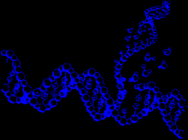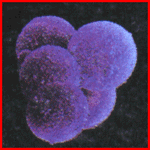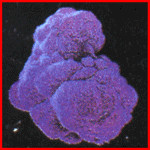|
Animal Hybrid Clones
Biotechnica has established a system in which vat grown humanoids can be
created and reach maturity in 2.5 years using the RG-Clone technologies. These creatures are "Custom Built" by combining human and animal DNA, and infusing the mix into the "Birthing Vat". The resulting creature ends up with the abilities and instincts of the Animal, and the learning capabilities of the Human. During the last 2 years of the birthing process, the clones are maintained in a braindance training environment.
In 2013, the federal courts made a ruling that genetically manipulated animals, even those with human DNA, "being made and not part of nature have no rights offered to them except for those predetermined by previous laws accorded to the treatment of animals." (In other words, legalized slavery)
1) Since they are not quite human to begin with, any cybernetics cost DOUBLE the Humanity Loss (in other words, you are making an animal a human, then changing it into a machine)
2) Since these Creatures reach maturity in just over a year, they will also grow old faster, figure 7 years per 1 human.
3) As a Player Character, the background will have to reflect one of three things,
escape, buy-out, or release of contract.
4) because of this, the background and starting equipment / euro will be determined by the GM.
5) Most of the animal types here (70%) will end up as expensive slave / servants, with some few being used as professionals in fields where their natural enhancements make them particularly useful (security work, animal handling, bouncers).
6) EMP is the most important stat of these created beings, also it is the hardest
to come by. Starting Characters pay DOUBLE for their initial EMP stat (MAX of 5).
7) All beings will be designed using BIOpoints for game balance. Below are the costs associated with the various options available for animal hybrid clones: 30 BIOpoints
[BIO cost is in Green]
| Claws | [4] | 1d6 damage, 1/2 SP, 1d3 Humanity Loss |
| Retractable Claws | [5] | 1d6 damage, 1/2 SP, 1d3 Humanity Loss |
| Climbing Claws | [1] | 1d2 Humanity Loss, must have claws, +2 climbing skill. |
| Digging | [2] | 1d2 Humanity Loss, must have claws, dig BODY/2 feet per minute. |
| Horns | [3] | 1d10 damage, 1d3+2 Humanity Loss |
| Sharp Horns | [5] | 1d10 damage, 1/2 SP, 1d3+2 Humanity Loss |
| Tusks | [3] | 1d10 damage, 1d6+1 Humanity Loss |
| Sharp Tusks | [5] | 1d10 damage, 1/2 SP, 1d6+1 Humanity Loss |
| Teeth | [1] | 1d3 damage, 1d6/3 Humanity Loss |
| Big Teeth | [2] | 1d6 damage, 1d3 Humanity Loss |
| Hooves | [2] | 1D6 Humanity Loss, Kick does +2 damage |
| Scent Pouch | [2] | 2d6 Humanity Loss, causes irritation, victims are -4 REF, and -4 COOL. 4 uses, recharges 1 use per 8 hours |
| Quills | [6] | +1d6 damage (1/2 SP) to hand-to-hand (punching and kicking) +2d6 (1/2 SP) to all grappling attacks, including being grappled, 3d6 Humanity Loss |
| Partial Biped | [1] | 3d6 Humanity Loss, +1 MA running on all four limbs, -4 MA, -1 REF running on two legs. +2 damage when kicking while on all four limbs. |
| Digitigrade Legs | [3] | 2d6 Humanity Loss, if the clone has a tail this gives +1 MA, +2 on athletics rolls and +2 kick damage, without a tail it provides -2 MA and -1 REF. Cannot be combined with Partial Biped. |
| Tail | [1] | 1d6 Humanity Loss, Acts as a counter-balance providing +1 on athletics rolls. |
| Prehensile Tail | [3] | 2d6 Humanity Loss, +1 athletics rolls as above, and can handle weapons, etc, at -4 REF and STR. |
| Jumping | [2] | 1d6 Humanity Loss, x2 jumping distance (x3 with digitigrade legs or partial biped). |
| Enhanced Metabolism | [6] | +2 MA, +4 initiative, -1 Endurance. Must consume double normal food quantity per day. Can be taken twice. |
| NightVision | [2] | see in near total darkness, including nighttime |
| Nictating Membrane | [1] | Provides protection against irritant gases and sandstorms, etc. |
| Enhanced Hearing | [2] | +2 awareness/notice using audio |
| Ultrasonic hearing | [1] | can hear beyond the normal human range |
| Enhanced Smell | [2] | +2 Awareness/Notice using smell |
| Enhanced Tracking Smell | [2] | +3 to Tracking skill, + Enhanced Smell |
| Enhanced Strength: +1 | [2] | 1d6/2 HL per point, max 5 points |
| Enhanced Size: +1 | [2] | 1d6/2 HL per BODY point, max 5 points |
| Enhanced Speed: +1 | [2] | 1d6/3 HL per MA point, max 5 points |
| Enhanced Reflexes: +1 | [3] | 1d6/2 HL per REF point, max 4 points |
| Fur | [2] | 1d3 HL, SP 4 (like leather) |
| Light Natural Body Armour | [4] | 1d6 HL, SP 9 (Rhinos, Elephants, Hippos) |
A sample NPC based on these rules is Donovan XF4.
|

These rules were written for the BlackHammer Cyberpunk Project rules, and therefore uses both strength and body stats as well as having higher costs for the clones.
With the use of Merits and Flaws to design clone characters, the character creation process is not actually fully compatible with the standard CP2020 rules, but works perfectly with the BlackHammer and Ocelot character systems. Otherwise, assume that flaws give extra skill points and merits cost skill points. In addition, Clones built using the classic CP2020 generation system can purchase higher stats at a cost of 4 skill points per stat point, representing their superior genetic engineering.
The original kick-ass rules for the Animal Hybrid Clones were created by Paul D Romine who has given me his kind permission to fiddle with them for use in this article. The original version is available on his New Tulsa 2020 website.
Special thanks also go out to the Safety Twins, Daniel-8 and Danielle-6 (D-6 and D-8), for making me finish off these zygotic rules that I had started on ages and ages ago.
Thanks to CarrotLove for the opportune timing of the Clone Jokes.
|





